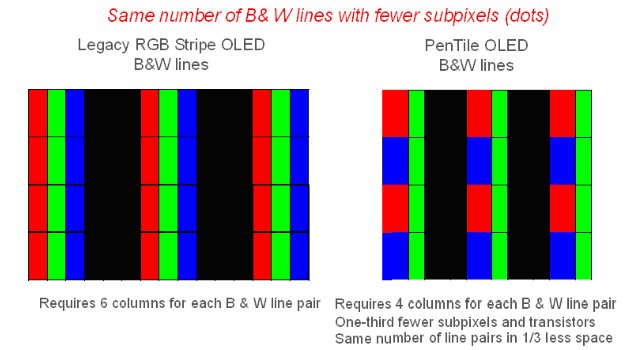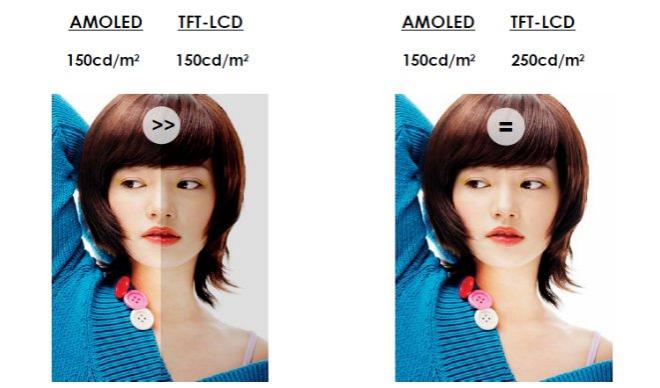A few days ago we posted about DisplayMate's Nexus-One display tests. Basically they are very unhappy with the OLED's performance, especially when compared to the iPhone's LCD.
Now Barry Young from the OLED-Association has sent us his response to these tests:
Last week, there was an incredible amount of Internet chatter, generated by one well-regarded tester (DisplayMate) and one blogger (DisplayBlog) comparing the AMOLED display in the Nexus I with the LTPS LCD in the iPhone. In short, according to the tester, the AMOLED didn’t measure up. The evaluation was, to my knowledge, the first in-depth scientific comparison of the two displays. Did they help or just confuse the situation? There was a time when display architectures and the measurements of performance were relatively simple:
- The use of power was simply measuring how much power the backlight used as the imaging electronics contributed very little to power consumption.
- The sub-pixel architecture was dominated by fixed groupings of rectangles of red, green and blue to create a pixel.
- Displays did not take into consideration the character of the eye (retina) to resolve colors and reduce power consumption.
- The backlight was either all on or off.
- The color depth was either 2, 4, 6, or 8 bits per sub-pixel, or some increases in bit depth were achieved using dithering, but the implementation for a particular panel was fixed.
- The brightness was determined simply by the number of candelas/m2.
- Adding a touch screen did not materially impact the front of screen performance as few used any touch screen.
Over the last two or three years, all of this has changed and hopefully for the better:
- New display technologies have been introduced, so when low peak brightness and low color saturation are used, the displays can reduce the power consumption. These features have been enabled by both LCDs (with content adjusted dimming) and OLEDs.
- Sophisticated pixel configurations have been designed for both LCDs and OLEDs that take advantage of the way that eyes resolve colors so that the least amount of power and the highest resolution with equivalent modulation ratio can be designed into the display.
- Drivers can be designed to support modes of multiple color depths, for example the gallery app might load thumbnails into a lower bit depth representation storing lots of thumbnails and animate them around, but when you click on an image, and zoom in on it, the image should be at full resolution and full bit-depth for the duration of the inspection.
- When test equipment measures luminance, it may not take into consideration the benefits of higher contrast ratio and the method of implementing color depth. Some OLED displays appear brighter than LCDs operating at the same luminance simply due to their extraordinary blacks and high contrast; meaning that the human eye perceives one display brighter than the other, even though the measurement equipment indicates that both displays are producing the same measured brightness in cd/m2. See Figure 2.
- Touch capability is typically an add-on to the actual display and capacitive touch adds a piece of glass or plastic with patterned ITO on ether side. Typically, there is a space between the touch component and the display. In this implementation the multiple optical index mismatches causes greater reflection and reduces the luminance and contrast.
Now along comes a series of new OLED displays and the image testing folks are challenged to determine if all of these changes actually produce better images and lower power consumption than the simple older displays of the past. Clearly consumers and media are able to see the difference.
- The Nexus One is slim and curvaceous, and the OLED display is just stunning. - cnet.
- The 3.7-inch, 800x480 AMOLED screen is undoubtedly the best we’ve seen on an Android phone yet, delivering crisp and bright colors and much less glare than the LCD efforts found on HTC’s older Android handsets and, of course, the iPhone. As a result, your eyes won’t start going squiffy after a few hours squinting at it.
- The colors are much more vibrant and the blacks are blacker, as evidenced by putting both side by side and hitting up various websites and loading various games. The pinks on Perez Hilton and the blues on Gizmodo just popped a lot more on the N1, and made the Droid (which was actually considered to have a great screen) seem washed out. The same feeling carries over when you compare the Nexus with the iPhone 3GS. And it’s pretty damn bright, compared to the other two phones. This is probably the best screen we’ve seen on a smartphone so far. - Gizmodo
- Different users may have different initial impressions on placing the AMOLED side-by-side with a more traditional backlit LCD screenArs Deputy Editor Jon Stokes found the AMOLED to be a striking improvement, but to me it first came off as dark and underwhelming. However, upon extended use, I have to say, this is better. … The brightness gamut is excellent. The OLED screen also has a much better viewing angle than a traditional LCD screen; this could be important for some car dock setups. Overall, I don’t think I’d trade this screen for the brighter Droid screen, or any other non-OLED screen.
- Although the Motorola Milestone has a screen with the same size as the Google Nexus One’s 3.7 inches and a few extra pixels (854 x480, to the Nexus One's 800x480) too, the Nexus One’s panel still outclasses it. That’s because it uses a different type of display, AMOLED, which many tip to be the next big thing in mobile. We’re not going to argue with them: it makes the Google Nexus One’s screen look absolutely glorious. Photos don’t quite do it justice, but take our word when we say the colors the screen produces are deeper and richer than on any previous Android phone. - Fonehome.
- The OLED screen on the Nexus One is spectacularblacks looked inky black. Next to an iPhone and Motorola Droid, the colors on the Nexus One were vivid - PC Magazine
One hopes that the tester’s truly understand and are set up to evaluate new sophisticated architectures and can invoke and properly utilize them. Measurements should always corroborate what observer’s experience, or one should reexamine why that may not be the case.
Dr. Raymond Soneira posted on his site, DisplayMate, a comprehensive comparison between the Nexus I OLED display and the iPhone' LTPS TFT LCD. Dr. Soneira compared images using his own test equipment and concluded that the images on the Nexus I had some serious flaws and showed these images in his report. His diagnosis was that the PenTile OLED subpixel arrangement, the 6-bit color depth, (really 5-6-5) and the high color saturation in the OLEDs were the cause. The Nexus I, however, has a feature that allows the system to use modes of both 5-6-5 bit or 8 bit color depth depending on the image and the designer’s choice. Typically, 8-bits are invoked when the user touches the screen. While Dr. Soneira acknowledges that nonbandwidth-limited content of text, icons and graphics are very crisp, he seems to indicate that the less challenging bandwidth-limited image content is less well rendered. He suggests that the PenTile configuration somehow reduces the resolution and limits the gray scale. This conclusion is just incorrect.
The VESA committee adopted a standard based upon modulation ratio where a series of black and white lines are written and the modulation ratio can be no more than 50% of the brightness in between each pixel. If the modulation ratio reaches 50%, the contrast modulation threshold is reached as is the limit of the resolution of that display device. VESA goes on to specify techniques for this measurement that reduces the errors in measurement associated with flare. The VESA spec is the only industry accepted standard for resolution, and it says nothing about counting dots, or how many subpixels per pixel are used. It can be applied to RGB stripe displays where there are 3 subpixels per pixel, frame sequential displays where there is only one subpixel per pixel, or PenTile displays where there are, on the average, two sub-pixels per pixel. As an example, consider how one can write vertical black and white line pairs with PenTile OLEDs as shown below. From the normal viewing distance these look the same to the user.
According to his report, Dr. Soneira tested only the 5-6-5 color depth mode and he did not use or perhaps figure out that the display had an 8-bit capability. Therefore, it would appear that the conclusions are based on some incorrect assumptions.
The work that Dr. Soneira has done is important and I urge him to ensure that he understands how PenTile technology works by talking to its inventor, and to redo the tests invoking the 8-bit capability the way the display was designed. Moreover, we should use this situation as a teaching moment.
If in fact the AMOLED display has flaws and it just may, Dr. Soneira would make a great contribution if he could identify the causes of the problem by disaggregating them:
- The selection of materials in the OLED.
- The PenTile display architecture.
- The way the gamma curve was implemented. For example, OLEDs and LCDs benefit from different gamma curves (due to the psychovisual properties of the human vision system in high contrast dark images in OLEDs versus the low level brightness of an LCD), so indicating that the OLED doesn’t perform the way an LCD does, is not necessarily an error.
- Implementation of how the multiple gray scales are selected.
Hopefully, this would shine some light on what causes the performance differences between the OLED and the LTPS LCD, which one is better and how it can be resolved. Condemning OLEDs, PenTile or the driving scheme is no longer sufficient, given the system level considerations of overall phone properties, interactions of the components and especially when so many users appreciate the viewing experience.

Source: Nouvoyance
Figure 2 OLED vs. TFTLCD at 250 cd/m2

Source: Samsung Mobile Display (validated by Nokia)

